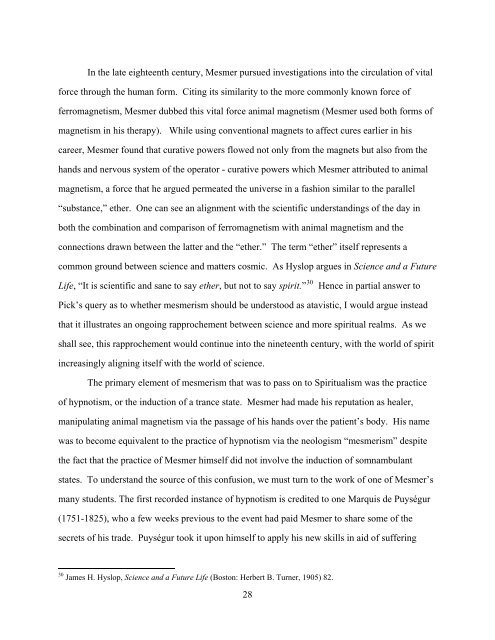A Genealogy of the Extraterrestrial in American Culture
A Genealogy of the Extraterrestrial in American Culture
A Genealogy of the Extraterrestrial in American Culture
You also want an ePaper? Increase the reach of your titles
YUMPU automatically turns print PDFs into web optimized ePapers that Google loves.
In <strong>the</strong> late eighteenth century, Mesmer pursued <strong>in</strong>vestigations <strong>in</strong>to <strong>the</strong> circulation <strong>of</strong> vital<br />
force through <strong>the</strong> human form. Cit<strong>in</strong>g its similarity to <strong>the</strong> more commonly known force <strong>of</strong><br />
ferromagnetism, Mesmer dubbed this vital force animal magnetism (Mesmer used both forms <strong>of</strong><br />
magnetism <strong>in</strong> his <strong>the</strong>rapy). While us<strong>in</strong>g conventional magnets to affect cures earlier <strong>in</strong> his<br />
career, Mesmer found that curative powers flowed not only from <strong>the</strong> magnets but also from <strong>the</strong><br />
hands and nervous system <strong>of</strong> <strong>the</strong> operator - curative powers which Mesmer attributed to animal<br />
magnetism, a force that he argued permeated <strong>the</strong> universe <strong>in</strong> a fashion similar to <strong>the</strong> parallel<br />
“substance,” e<strong>the</strong>r. One can see an alignment with <strong>the</strong> scientific understand<strong>in</strong>gs <strong>of</strong> <strong>the</strong> day <strong>in</strong><br />
both <strong>the</strong> comb<strong>in</strong>ation and comparison <strong>of</strong> ferromagnetism with animal magnetism and <strong>the</strong><br />
connections drawn between <strong>the</strong> latter and <strong>the</strong> “e<strong>the</strong>r.” The term “e<strong>the</strong>r” itself represents a<br />
common ground between science and matters cosmic. As Hyslop argues <strong>in</strong> Science and a Future<br />
Life, “It is scientific and sane to say e<strong>the</strong>r, but not to say spirit.” 30<br />
Hence <strong>in</strong> partial answer to<br />
Pick’s query as to whe<strong>the</strong>r mesmerism should be understood as atavistic, I would argue <strong>in</strong>stead<br />
that it illustrates an ongo<strong>in</strong>g rapprochement between science and more spiritual realms. As we<br />
shall see, this rapprochement would cont<strong>in</strong>ue <strong>in</strong>to <strong>the</strong> n<strong>in</strong>eteenth century, with <strong>the</strong> world <strong>of</strong> spirit<br />
<strong>in</strong>creas<strong>in</strong>gly align<strong>in</strong>g itself with <strong>the</strong> world <strong>of</strong> science.<br />
The primary element <strong>of</strong> mesmerism that was to pass on to Spiritualism was <strong>the</strong> practice<br />
<strong>of</strong> hypnotism, or <strong>the</strong> <strong>in</strong>duction <strong>of</strong> a trance state. Mesmer had made his reputation as healer,<br />
manipulat<strong>in</strong>g animal magnetism via <strong>the</strong> passage <strong>of</strong> his hands over <strong>the</strong> patient’s body. His name<br />
was to become equivalent to <strong>the</strong> practice <strong>of</strong> hypnotism via <strong>the</strong> neologism “mesmerism” despite<br />
<strong>the</strong> fact that <strong>the</strong> practice <strong>of</strong> Mesmer himself did not <strong>in</strong>volve <strong>the</strong> <strong>in</strong>duction <strong>of</strong> somnambulant<br />
states. To understand <strong>the</strong> source <strong>of</strong> this confusion, we must turn to <strong>the</strong> work <strong>of</strong> one <strong>of</strong> Mesmer’s<br />
many students. The first recorded <strong>in</strong>stance <strong>of</strong> hypnotism is credited to one Marquis de Puységur<br />
(1751-1825), who a few weeks previous to <strong>the</strong> event had paid Mesmer to share some <strong>of</strong> <strong>the</strong><br />
secrets <strong>of</strong> his trade. Puységur took it upon himself to apply his new skills <strong>in</strong> aid <strong>of</strong> suffer<strong>in</strong>g<br />
30 James H. Hyslop, Science and a Future Life (Boston: Herbert B. Turner, 1905) 82.<br />
28















